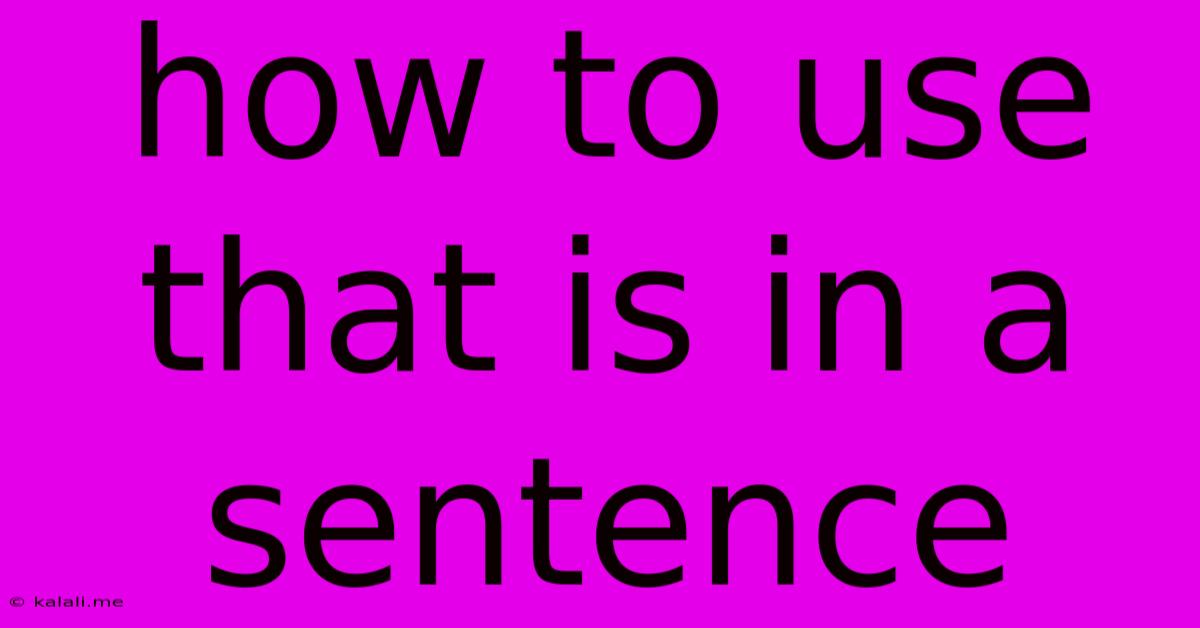How To Use That Is In A Sentence
Kalali
Jun 02, 2025 · 3 min read

Table of Contents
Mastering the Art of "That" in a Sentence: A Comprehensive Guide
This article will delve into the multifaceted uses of the word "that" in English grammar. We'll explore its various functions as a pronoun, a relative pronoun, a conjunction, and even an adverb, providing clear examples to solidify your understanding and improve your writing. Understanding how and when to use "that" correctly is crucial for clear and effective communication.
What is "That"?
"That" is one of the most versatile words in the English language. Its function often depends on its context within the sentence. It can act as a demonstrative pronoun, a relative pronoun, a conjunction, or even as an adverb in informal speech. Mastering its different uses will elevate your writing skills significantly.
1. "That" as a Demonstrative Pronoun:
A demonstrative pronoun points to a specific noun or noun phrase. "That" indicates something further away from the speaker than "this."
- Example: "That is a beautiful sunset." Here, "that" refers to a specific sunset visible to both the speaker and the listener.
- Example: "That's the car I want to buy." Here, "that" specifically identifies a particular car.
2. "That" as a Relative Pronoun:
A relative pronoun introduces a relative clause, providing additional information about a noun or pronoun. As a relative pronoun, "that" refers back to the noun it modifies. It can replace "who," "whom," "which," or "whose," but often results in a more concise sentence.
- Example: "The book that I borrowed is overdue." Here, "that" refers to "book" and introduces the relative clause "that I borrowed."
- Example: "The car, that was red, sped away." Here, "that" could be replaced by "which" to sound slightly more formal.
3. "That" as a Conjunction:
As a conjunction, "that" introduces a subordinate clause. This clause adds more information to the main clause, often explaining a reason, result, or purpose. It is often omitted in informal speech, but it should be included in formal writing.
- Example: "She said that she would be late." Here, "that" introduces the subordinate clause "she would be late," explaining what she said.
- Example: I'm happy that you're here. Here "that" introduces a reason for happiness.
4. "That" as an Adverb (Informal):
In informal speech, "that" can function as an adverb, intensifying an adjective or adverb. This usage is not considered grammatically correct in formal writing.
- Example: "That's a really good idea!" Here, "that" adds emphasis to the adjective "good".
Common Mistakes to Avoid:
- Unnecessary "That": Avoid using "that" when it's not needed. For example, "I think that it will rain" can be shortened to "I think it will rain".
- Incorrect Pronoun Use: Ensure that "that" agrees with the noun it refers to in number and gender (if applicable).
- Comma Splices: Don't use "that" to connect two independent clauses without proper punctuation.
Conclusion:
The word "that" plays a crucial role in the English language, capable of performing multiple grammatical functions. Understanding its various uses allows for more precise and effective writing. By carefully considering the context and avoiding common mistakes, you can master the art of using "that" correctly in your sentences. This will significantly improve the clarity and professionalism of your writing across various contexts. Remember to practice regularly to solidify your understanding and enhance your writing skills.
Latest Posts
Latest Posts
-
2015 Hyundai Sonata Limited Engine Doesnt Go Beyond 60
Jun 04, 2025
-
Kitchen Sink Drain Already Has A White Gasket
Jun 04, 2025
-
Where To Star Watching Vampire Diaries Without Missing Important Things
Jun 04, 2025
-
How To Find Average Value Of A Function
Jun 04, 2025
-
Is The Cramer Von Mises Distance A Metric
Jun 04, 2025
Related Post
Thank you for visiting our website which covers about How To Use That Is In A Sentence . We hope the information provided has been useful to you. Feel free to contact us if you have any questions or need further assistance. See you next time and don't miss to bookmark.